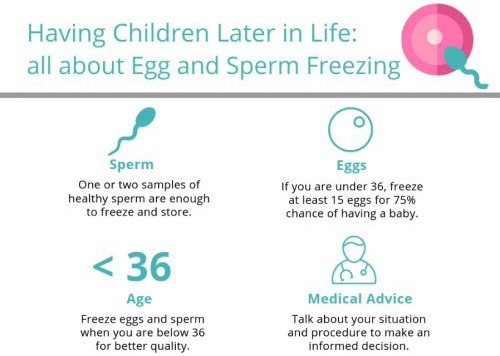 HAVING CHILDREN LATER IN LIFE
HAVING CHILDREN LATER IN LIFE
If you are planning to have children later in life, you are not alone. More and more people are choosing to prioritise their careers and work life. This gives them the financial freedom to buy a house, find a partner and then have children. However, having children later in life is not always straightforward. In fact, fertility declines with age, and some people delaying parenthood may find it hard to get pregnant.
Fertility preservation is a new technique that allows people to freeze their eggs and sperm when they are young and use them later when they feel ready to build their families. In this article we talk about fertility preservation so you can decide if it’s right for you.
WHAT IS FERTILITY PRESERVATION?
Fertility preservation involves freezing and storing sperm, eggs or embryos with the intent of using them to have children later in life. This is an option for people who don’t want children right now, or to those who become infertile due to illness or treatment (like cancer and chemotherapy).
WHAT IS THE BEST AGE TO FREEZE EGGS OR SPERM?
Research shows the highest live birth rates from own frozen eggs are from women who have frozen eggs before they were 30. These eggs are likely of better quality, improving chances when you decide to use them.
However, HFEA data shows most women freeze their eggs around 37. This is a concern because this is the age when fertility starts declining. If you want to guarantee better quality eggs and higher chance of live birth rates, it is better to freeze before you reach 36.
As sperm quality also declines with age, it is recommended you freeze sperm before you reach 36.
WHAT DOES FERTILITY PRESERVATION INVOLVE?
Freezing sperm is relatively easy. The process involves masturbation and collecting semen. If there is a condition where masturbation is not possible, sperm can also be collected surgically. Sperm collected is frozen in liquid nitrogen and stored for future use in a process known as cryopreservation.
The egg freezing process is a bit more complex than sperm, as it involves a surgery to remove the eggs from the ovaries. Each month, a woman produces a single mature egg. However, for egg freezing, a woman needs to stimulate her ovaries to produce several eggs. This is achieved with daily injections of FSH over a period of 10 to 14 days. Once the follicles have reached an adequate size, the woman injects GnRHa to prevent ovarian hyperstimulation and encourage the eggs to mature. These eggs will be collected 36 to 40 hours later, via a surgical procedure and under guidance of an ultrasound. You will be under sedation or general anaesthetic for this procedure. After the procedure, you may notice some vaginal bleeding and abdominal cramps. This is a minimally invasive procedure and the risks are less than 1 in 1000, but include bleeding, bowel or bladder perforation and possible infection. The eggs collected will be frozen for future use.
HOW MANY SPERM AND EGGS SHOULD I FREEZE?
Man produce a lot of sperm in each ejaculate. Sperm counts vary from about 20 million to 100 million sperm cells per ml of ejaculate. Healthy men produce from 1.5 ml to 5 ml of semen each time they ejaculate. So, a healthy sperm sample or two will be enough to freeze.
When it comes to eggs, it’s a bit more challenging. Research shows, that a 34-year-old woman needs to freeze 10 eggs for a 75% chance of having a baby. If the woman is 37, she needs to freeze 20 eggs for that same chance. And when she reaches 42, she needs to freeze 61 eggs for those 75% chance of having a baby.
This increase accounts for the egg quality that reduces as women age and the fact that not all eggs retrieved will survive the process of being frozen, thawed, fertilized, develop into an embryo and implant in the uterus.
The number of eggs collected in each stimulation cycle also varies. This is affected by the woman’s age, the ovarian reserve and how her body responds to the stimulation. Some women may produce 15 eggs in one cycle whist other may need several cycles to reach that number.
WHAT ARE THE CHANCES OF SUCCESS?
Once collected, not all eggs, sperm and embryos survive the freezing and thawing process. One of the reasons is related to the freezing methods: Slow freezing or Flash freezing.
The process of slow freezing takes a couple of hours, until the final storing temperature is reached. On the other hand, the most recent method of flash freezing (or vitrification) is much quicker, preventing ice crystals and avoiding trauma to the egg, embryo or blastocyst.
Flash freezing seems to have better chances of success once the eggs, sperm and embryos are thawed to be used. Embryos have a 95% freeze-thaw survival rate (compared to 50% survival with slow freezing). This is also a better technique for egg freezing which have an over 90% freeze-thaw survival rate (compared to the approximately 66% survival rate of eggs during slow freezing).
HAVING CHILDREN LATER IN LIFE
If you are young and not ready to have children right now, but want to have them later, it may be worth it to consider fertility preservation. It’s not an absolute guarantee but it gives you more options to plan for a family. Speak with your doctor about your situation. You may also speak with a counsellor who can help you reflect on the procedure and implications, so you can make an informed choice.